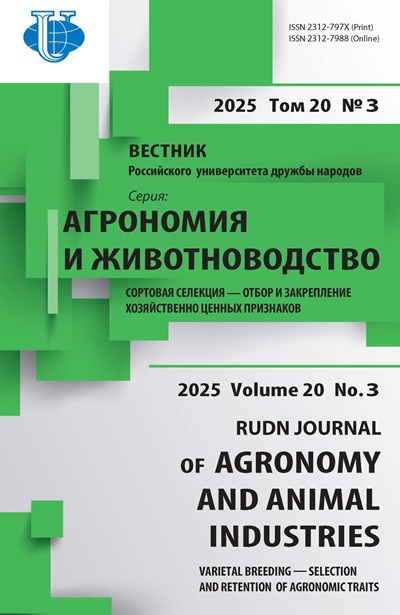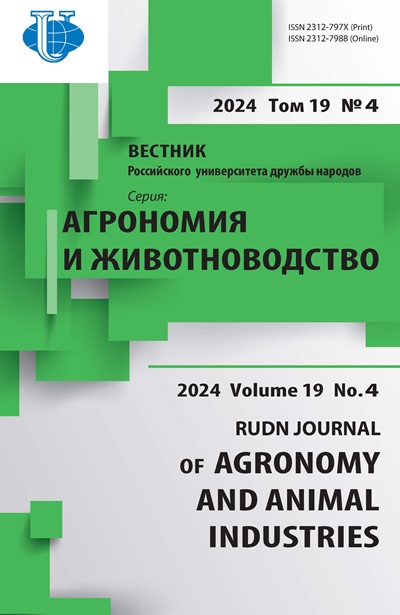Evaluation of hematological parameters in cats with intestinal lymphoma
- Authors: Goncharova A.V.1, Atabaeva T.K.1, Kostylev V.A.1
-
Affiliations:
- Moscow State Academy of Veterinary Medicine and Biotechnology named after K.I. Skryabin
- Issue: Vol 19, No 4 (2024)
- Pages: 685-695
- Section: Veterinary science
- URL: https://agrojournal.rudn.ru/agronomy/article/view/20134
- DOI: https://doi.org/10.22363/2312-797X-2024-19-4-685-695
- EDN: https://elibrary.ru/CSMCLQ
- ID: 20134
Cite item
Full Text
Abstract
Nowadays intestinal lymphoma is considered to be the most common tumor of alimentary tract in cats. The disease is characterized by severe course and poor response to chemotherapy. Since this tumor shares clinical and ultrasound characteristics with inflammatory bowel disease, the diagnosis is challenging and requires a variety of diagnostic modalities, including blood tests. Thus, the purpose of the research was to evaluate hematological parameters of cats with intestinal lymphoma. The diagnosis was confirmed using cytological and histological examinations. The objects of the research were cats of various breeds (20 animals in total), various sex and age groups. All animals underwent a clinical examination using standard methods, ultrasonographic examination of the abdominal cavity, and hematological studies. It was established that there was no correlation between disease stage and blood parameters. It was found that the first stage was not accompanied by changes in hematological parameters, the second stage was characterized by an increase in urea concentration (15.9 ± 7.9 mmol/l), the third stage was accompanied by an increase in ALT (115.6 ± 120.7 U/l) and AST (97 ± 96.1 U/l), fourth stage was characterized by an increase in leukocytes (19.4 ± 18.96), AST (134.6 ± 242), urea (18.5 ± 20.1) and creatinine (239.8 ± 257.1). The level of the blood parameters’ increase can be characterized as moderate and its origin is associated with progressive destruction of muscle mass, presence of concomitant diseases, but not with the tumor growth. The exception is an increased content of leukocytes in the blood, which can be explained by the body’s increased need for phagocytosis.
Full Text
Table 1
Indicators of general clinical blood test in cats with intestinal lymphoma at different stages
Indicator | Reference values | Stage 1 | Stage 2 | Stage 3 | Stage 4 |
Leukocytes, 109/L | 5.5…19.5 | 9.7 ± 1.4 | 12.5 ± 2.4 | 12.45 ± 2.37 | 19.4 ± 5.2 |
Hemoglobin, g/L | 85.0…182.0 | 138.0 ± 4.2 | 112.0 ± 27.0 | 119.0 ± 8.5 | 118.2 ± 7.7 |
Hematocrit, g/L | 26.0…61.0 | 39.9 ± 1.6 | 32.3 ± 9.4 | 34.5 ± 2.2 | 35.7 ± 2.4 |
Erythrocytes, 1012/L | 4.60…12.18 | 10.18 ± 0.61 | 7.1 ± 1.2 | 8.6 ± 0.6 | 8.4 ± 0.78 |
Mean corpuscular volume (MCV) | 38.0…54.0 | 39.6 ± 2.3 | 44.5 ± 5.8 | 39.9 ± 1.01 | 41.1 ± 2.8 |
Mean corpuscular hemoglobin (MCH) | 11.8…19.7 | 13.7 ± 0.8 | 15.6 ± 1.2 | 13.9 ± 0.48 | 14.5 ± 0.51 |
Mean corpuscular hemoglobin concentration (MCHC) | 33.0…360.0 | 346.8 ± 6.3 | 352.5 ± 18.5 | 345.6 ± 5.84 | 337.5 ± 5.2 |
Neutrophils,% | 3.12…12.58 | 17.9 ± 12.3 | 9.6 ± 2.6 | 7.97 ± 2.89 | 9.16 ± 1.55 |
Lymphocytes,% | 0.73…7.86 | 2.9 ± 0.4 | 2.17 ± 0.39 | 1.9 ± 0.3 | 2.26 ± 0.54 |
Monocytes,% | 0.07…1.36 | 0.31 ± 0.06 | 0.42 ± 0.17 | 0.27 ± 0.12 | 0.54 ± 0.17 |
Eosinophils,% | 0.06…1.93 | 0.55 ± 0.12 | 0.26 ± 0.04 | 0.92 ± 0.49 | 0.6 ± 0.22 |
Basophils,% | 0.00…0.12 | 0 | 0 | 0.02 ± 0.001 | 0.01 ± 0.01 |
Thrombocytes, thousand (PLT) | 100.0…730.0 | 271.2 ± 28.5 | 393.5 ± 149.5 | 317.3 ± 135.01 | 335.2 ± 36.24 |
Note. p = 0.05.
Source: completed by A.V. Goncharova, T.K. Atabaeva, V.A. Kostylev.
Table 2
Serum biochemistry parameters in cats with intestinal lymphoma at different stages
Indicator | Reference values | Stage 1 | Stage 2 | Stage 3 | Stage 4 |
ALT, U/L | 22.0…84.0 | 61.0 ± 5.0 | 67.5 ± 18.5 | 115.6 ± 69.7 | 60.3 ± 12.7 |
AST, U/L | 18.0…51.0 | 25.8 ± 1.9 | 31.0 ± 5.0 | 97.0 ± 68.0 | 134.6 ± 82.6 |
Total protein, g/L | 57.0…78.0 | 71.8 ± 1.6 | 69.5 ± 9.5 | 63.3 ± 2.6 | 62.15 ± 2.71 |
Total bilirubin, μmol/L | 2.0…7.0 | 3.0 ± 0.04 | 2.0 ± 1.0 | 5.0 ± 1.0 | 5.65 ± 1.55 |
Albumin, g/L | 23.0…35.0 | 35.8 ± 0.9 | 34.5 ± 2.5 | 27.0 ± 1.0 | 53.15 ± 27.81 |
GGT, U/L | 1.0…10.0 | 2.8 ± 1.8 | 4.0 ± 1.0 | 2.5 ± 1.5 | 4.2 ± 1.1 |
Urea, mmol/L | 6.28…11.71 | 10.4 ± 0.4 | 16.0 ± 5.6 | 7.5 ± 0.39 | 20.28 ± 6.08 |
Creatinine, μmol/L | 71.0…159.0 | 130.2 ± 5.6 | 97.5 ± 14.5 | 104.6 ± 8.2 | 239.8 ± 78.3 |
Alkaline phosphatase, U/L | 9.0…53.0 | 45.4 ± 3.1 | 47.5 ± 3.5 | 36.0 ± 4.5 | 35.3 ± 5.9 |
Phosphorus, mmol/L | 0.84…1.94 | 1.34 ± 0.07 | 1.4 ± 0.2 | 1.62 ± 0.04 | 1.62 ± 0.26 |
Sodium, mmol/L | 143.0…165.0 | 150.8 ± 1.9 | 147.0 ± 5.0 | 153.0 ± 3.0 | 150.09 ± 1.69 |
Potassium, mmol/L | 4.1…5.4 | 3.88 ± 0.15 | 3.9 ± 0.2 | 5.05 ± 0.85 | 3.8 ± 0.2 |
Chloride, mmol/L | 107.0…122.0 | 115.8 ± 1.6 | 116.0 ± 6.0 | 116.5 ± 0.5 | 117.17 ± 1.42 |
Glucose, mmol/L | 3.9…8.2 | 4.79 ± 0.36 | 7.45 ± 0.95 | 6.03 ± 0.13 | 6.4 ± 0.4 |
Note. p = 0.05.
Source: completed by A.V. Goncharova, T.K. Atabaeva, V.A. Kostylev.
Table 3
Calculations of nonparametric Kruskal — Wallis test and asymptotic significance for four independent small samples
Blood indicators | H Kruskal — Wallis | Asymptotic significance (two-sided) |
Basophils,% | 8.809 | 0.032 |
Albumin, g/L | 8.848 | 0.031 |
Urea, mmol/L | 7.891 | 0.048 |
Glucose, mmol/L | 9.842 | 0.020 |
Source: completed by A.V. Goncharova, T.K. Atabaeva, V.A. Kostylev.
About the authors
Anna V. Goncharova
Moscow State Academy of Veterinary Medicine and Biotechnology named after K.I. Skryabin
Email: annatrukhan@mail.ru
ORCID iD: 0000-0002-2142-2507
SPIN-code: 9362-5847
Doctor of Veterinary Sciences, Associate Professor, Professor of the Department of Veterinary Surgery
23 Akademika Skryabina st., Moscow, 109472, Russian FederationTatiana K. Atabaeva
Moscow State Academy of Veterinary Medicine and Biotechnology named after K.I. Skryabin
Author for correspondence.
Email: tanya-atabaeva@yandex.ru
ORCID iD: 0009-0008-5749-7050
PhD student
23 Akademika Skryabina st., Moscow, 109472, Russian FederationVladislav A. Kostylev
Moscow State Academy of Veterinary Medicine and Biotechnology named after K.I. Skryabin
Email: vetsurgery1@gmail.ru
ORCID iD: 0000-0003-1405-4213
SPIN-code: 9017-6331
Candidate of Veterinary Sciences, Associate Professor, Associate Professor of the Department of Veterinary Surgery
23 Akademika Skryabina st., Moscow, 109472, Russian FederationReferences
- Atabaeva TK, Goncharova AV, Kostylev VA. Ultrasonographic prerequisites and substantiation of stages of intestinal lymphoma development in cats. Veterinariya. Zootekhniya i biotekhnologiya. 2023;2(12):31—37. (In Russ.). doi: 10.36871/vet.zoo.bio.202312203
- Atabaeva TK, Goncharova AV, Kostylev VA Analysis of anamnestic data and their role in occurrence and development of intestinal lymphoma in cats. Bulletin of Altai state agricultural university. 2023;(3):75—79. (In Russ.). doi: 10.53083/1996-4277-2023-221-3-75-79
- Gnezdilova LA, Panin AN, Pozyabin SV, Selina MV, Borunova SM. Diagnosis and prevention of infectious animal diseases based on monitoring. molecular diagnostics. and genomics. International Journal of Ecosystems and Ecology Science. 2022;12(3):459—470. doi: 10.31407/ijees12.358
- Mazurov VI, Krivolapov YA. Classification of lymphomas. Morphology. immunophenotype. molecular genetics of non-Hodgkin’s lymphomas. Practical oncology. 2004;5(3):169—175. (In Russ.).
- Andreenko AA, Pozyabin SV. Features of diagnosis obstruction of the digestive tract in cats. Veterinariya. Zootekhniya i biotekhnologiya. 2016;(1):6—11. (In Russ.).
- Krivchikova YM. Estimation of selected biochemical blood parameters in patients with breast cancer undergoing chemotherapy with taxanes. Scientific result. Physiology Series. 2016;2(1):36—41. (In Russ.). doi: 10.18413/2409-0298-2016-2-1-36-41
- Vilmis DA. Hematological manifestations of paraneoplastic syndromes in dogs. International Journal of Veterinary Medicine. 2024;(1):381—391. (In Russ.). doi: 10.52419/issn2072-2419.2024.1.381
- Frantsyants EM, Bandovkina VA, Kushtova LB, Nikolaeva NV, Lysenko IB, Pushkareva TF. et al. Possibility of predicting the development of relapse in diffuse large B-cell lymphoma using indicators of a general blood test. Modern problems of science and education. 2021;(3):169. (In Russ.). doi: 10.17513/spno.30935
- Vail DM, Moore AS, Ogilvie GK, Volk LM. Feline lymphoma (145 cases): proliferation indices. cluster of differentiation 3 immunoreactivity and their association with prognosis in 90 cats. J Vet Intern Med. 1998;12(5):349—354. doi: 10.1111/j.1939-1676.1998.tb02134.x
- Barrs V, Beatty J. Feline alimentary lymphoma: 1. Classification. risk factors. clinical signs and non-invasive diagnostics. Journal of Feline Medicine and Surgery. 2012;14(3):182—190. doi: 10.1177/1098612X12439265
- Kiselow MA, Rassnick KM, McDonough SP, Goldstein RE, Simpson KW, Weinkle TK. et al. Outcome of cats with low-grade lymphocytic lymphoma: 41 cases (1995–2005). J Am Vet Med Assoc. 2008;232(3):405—410. doi: 10.2460/javma.232.3.405
- Vail DM, Thamm DH, Liptak JM. Small animal clinical oncology. 6th ed. Withrow & MacEwen’s; 2020.
- Sykes JE. Greene’s infectious diseases of the dog and cat. 5th ed. Elsevier Health Sciences; 2022.
- Lenkova NV, Wolf AV. Characteristics of functional and laboratory parameters in alimentary lymphoma in cats. International Journal of Veterinary Medicine. 2022;(4):241—246. (In Russ.). doi: 10.52419/issn2072-2419.2022.4.241
- Grigorieva II, Raskina TA, Letaeva MV, Malyshenko OS, Averkieva YV, Masenko VL. et al. Sarcopenia: pathogenesis and diagnosis. Fundamental and Clinical Medicine. 2019;4(4):105—116. (In Russ.). doi: 10.23946/2500-0764-2019-4-4-105116
- Ferreri AJM, Ernberg I, Copie-Bergman C. Infectious agents and lymphoma development: molecular and clinical aspects. J Vet Intern Med. 2009;265(4):421—438. doi: 10.1111/j.1365-2796.2009.02083.x
- Louwerens M, London CA, Pedersen NC, Lyons LA. Feline lymphoma in the post-feline leukemia virus era. J Vet Intern Med. 2005;19(3):329—335. doi: 10.1892/0891-6640(2005)19[329: flitpl]2.0.co;2
- Stein TJ, Pellin M, Steinberg H, Chun R. Treatment of feline gastrointestinal small-cell lymphoma with chlorambucil and glucocorticoids. J Am Anim Host Assoc. 2010;46(6):413—417. doi: 10.5326/0460413
Supplementary files















